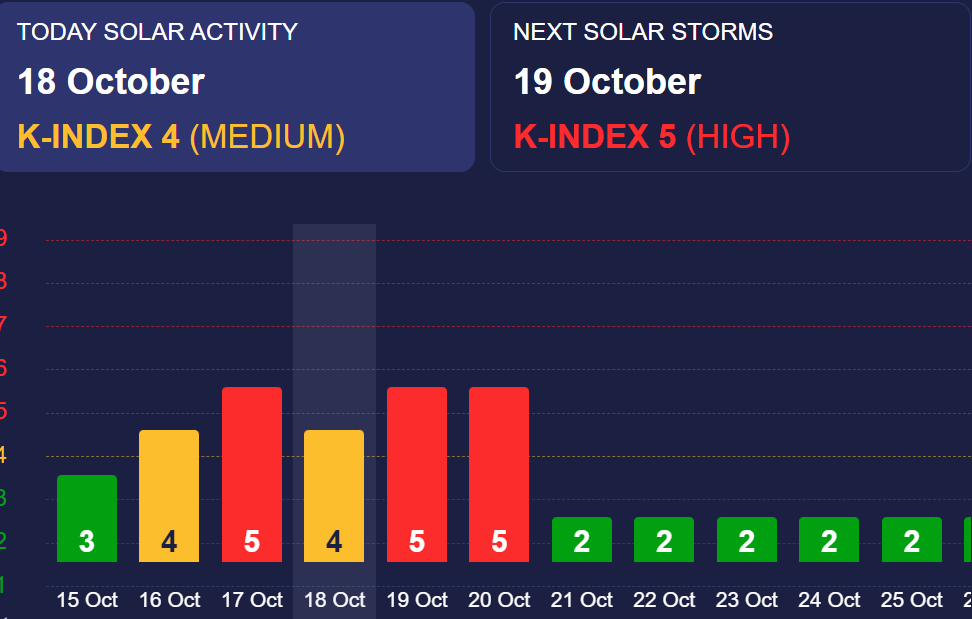Magnetic storm to hit Earth - Red-level
 A magnetic storm will hit Earth in the next 24 hours (photo: RBC-Ukraine Collage)
A magnetic storm will hit Earth in the next 24 hours (photo: RBC-Ukraine Collage)
A magnetic storm will affect Earth, and according to experts' forecasts, it will reach a K-index of 5, which corresponds to a red level. Furthermore, this storm will last at least two days.
What to know about this magnetic storm and how to protect yourself from its effects, according to Meteoagent.
What is magnetic storm
Various solar eruptions frequently occur on the Sun, through which solar energy is released in various directions. These eruptions can vary in magnitude, from small flares to large solar flares.
During such eruptions, solar energy is scattered in different directions, including towards Earth. This energy consists of charged particles (protons and electrons) that can move very rapidly through space.
When these particles interact with Earth's magnetosphere, they trigger geomagnetic activity, commonly referred to as a solar or magnetic storm.
The consequences of magnetic storms can vary and depend on the magnitude of the solar flares. In the case of minor magnetic storms, the disturbances are typically not very noticeable, and these storms are classified with a K-index of 2 or 3.
Magnetic storms with a K-index above 4 may lead to noticeable effects, including disruptions in power grids, satellite operations, GPRS, and mobile communication. Magnetic storms with a K-index above 6 can also result in polar auroras.
Additionally, magnetic storms can affect people's well-being. They often cause headaches and mild overall discomfort.
Magnetic storm in October
According to data from NOAA satellite systems, TESIS, and international meteorological laboratories worldwide, a magnetic storm with a K-index of 5 will affect Earth on Thursday, October 19. This storm is classified as a red-level storm.
This storm will be prolonged and extend for two days, on October 19 and 20. The magnetosphere is expected to return to a calm state on Saturday, October 21.

Magnetic storm on October 19-20 (screenshot)
How does a magnetic storm affect a person
Among scientists worldwide, there is no consensus on the impact of a magnetic storm on a person. Nevertheless, there are numerous studies that confirm the relationship between worsened well-being and magnetic storms.
Usually, on such days, the number of complaints about general health and headaches increases. People also seek medical assistance more frequently than usual, especially from cardiologists.
The most common complaints include:
-
Headaches, migraines, and dizziness
-
Insomnia or increased sleepiness
-
General deterioration of well-being and weakness
-
Rapid fatigue, reduced productivity, and concentration
-
Depression, heightened anxiety, irritability, and aggression
But the greatest danger of magnetic storms is posed to astronauts who are outside the protective shield of the Earth's atmosphere. They can be exposed to high levels of radiation, significantly increasing the risk of developing cancer.
How to protect yourself from the impact of a magnetic storm
Medical professionals recommend that weather-sensitive individuals pay more attention to their health, avoid overexertion, and get more rest.
General recommendations
-
Maintain a regular sleep schedule (get at least 7-9 hours of sleep per day)
-
Stick to a normal daily routine
-
Balance work and rest
-
Eat a well-balanced diet and consume an adequate amount of water
-
Ensure you go for walks during the day in the open air
-
Minimize stress, physical, and psychosocial stressors
-
Seek advice from a family or medical doctor if necessary
This material is for informational purposes only and should not be used for medical diagnosis or self-treatment. Our goal is to provide readers with accurate information about symptoms, causes, and methods of detecting diseases. RBС-Ukraine is not responsible for any diagnoses that readers may make based on materials from the resource. We do not recommend self-treatment and advise consulting a doctor in case of any health concerns.

